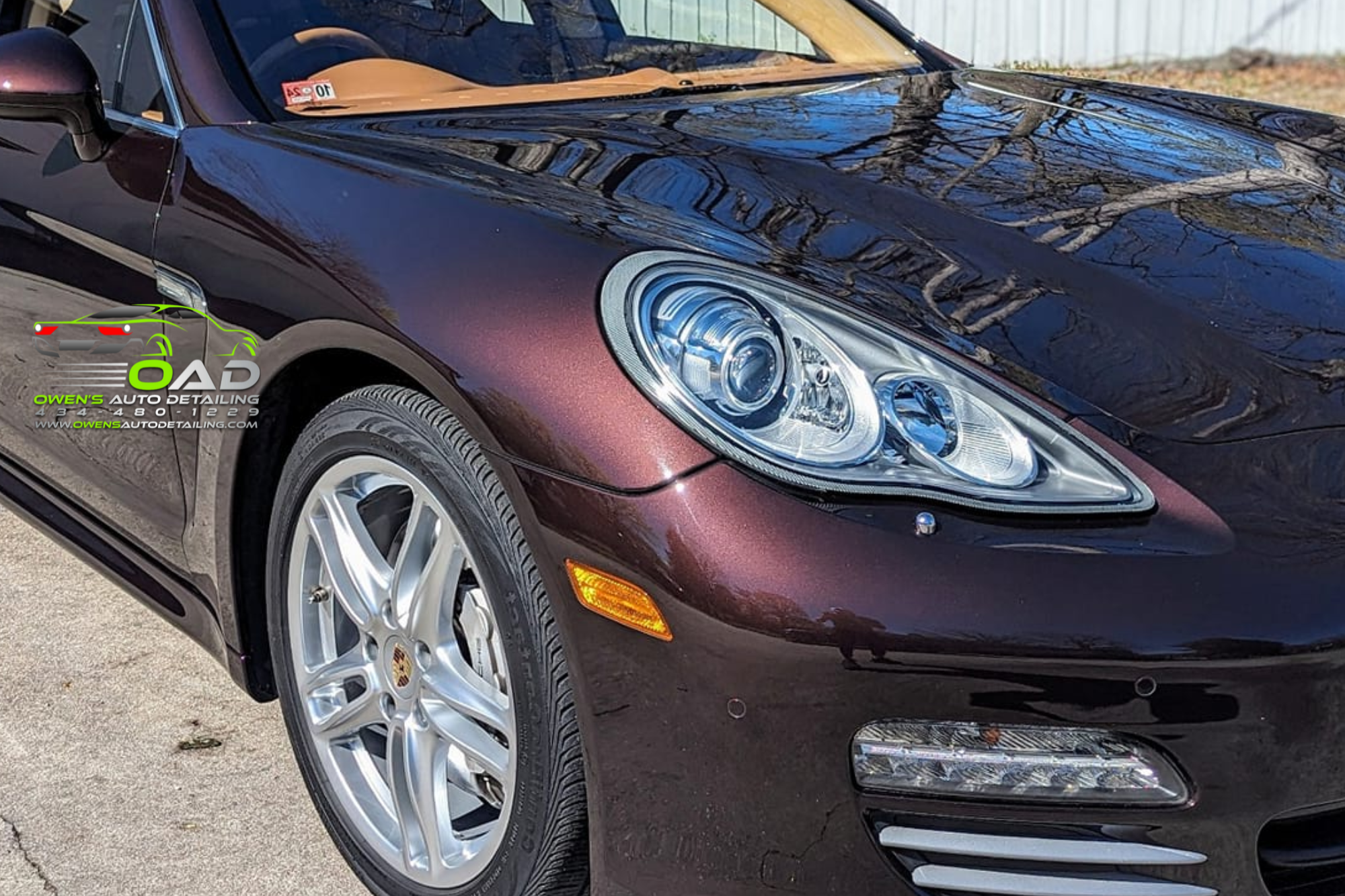Sun damage to your car’s interior is primarily caused by harmful ultraviolet (UV) rays, specifically UVA and UVB. These rays penetrate deeply into materials, breaking down chemical bonds in upholstery dyes and finishes, causing your car’s interior to fade and deteriorate over time. Additionally, intense infrared heat amplifies this damage by increasing interior temperatures. From leather seats cracking and discoloring to plastic and vinyl surfaces becoming brittle, sun damage significantly reduces your vehicle’s aesthetic appeal and value. There’s more to learn about how to identify these signs early and improve your car’s resistance to these hidden assailants.
Key Takeaways
- Car interiors fade due to UV rays breaking down chemical bonds in upholstery dyes and finishes.
- UV exposure dries and discolors leather, and it also makes fabric upholstery fade and become brittle.
- Sunlight can cause plastic and vinyl surfaces to turn chalky and brittle over time.
- The sun’s heat intensifies damage by increasing the car’s interior temperature, causing materials like trim to melt.
- Direct, frequent sun exposure can result in uneven color patches, indicating sun damage.
Understanding Ultraviolet (UV) Rays
While we often appreciate the sun for its warmth and light, it’s crucial to understand that it also emits Ultraviolet (UV) rays that can cause significant damage to your car’s interior.
UV rays are a type of electromagnetic radiation that is shorter in wavelength than visible light but longer than X-rays. These rays are divided into three categories: UVA, UVB, and UVC.
UVA rays, which have the longest wavelength, penetrate deep into the materials of your car’s interior, weakening its structure. UVB rays, which have a medium wavelength, mainly affect the surface, causing discoloration and fading. UVC rays are the most harmful, but they’re mostly absorbed by the Earth’s ozone layer.
UV rays have a greater impact on certain materials. Leather, for example, can dry out, crack, and discolor due to UV exposure. Fabric upholstery fades, weakens, and becomes brittle. Plastic and vinyl surfaces can discolor, turn chalky, and become brittle as well.
Understanding UV rays and their effects is the first step in preventing sun damage. By acknowledging this, you’re better equipped to protect your car’s interior from UV rays, preserving its aesthetic appeal and value.
If you’re exploring sun protection solutions, consider the best window tint to help block UVA and UVB rays effectively.
Effects of Sunlight on Car Interiors
Despite the common misconception that sun damage merely affects the exterior of your vehicle, it’s the car’s interior that often bears the brunt of this exposure.
UV radiation, the most potent form of sunlight, gradually breaks down the chemical bonds in your car’s upholstery dyes and finishes. This results in an insidious fading and weakening of your car’s interior materials.
Leather, a common choice for luxury interiors, can become dry, cracked, and discolored in harsh sunlight. Fabric, another popular choice, fades, weakens, and becomes brittle under the same conditions.
Plastic and vinyl, often used for dashboards and interior trim, are no exception. Exposure to sunlight can cause these materials to become discolored, chalky, and brittle over time.
Infrared heat, another form of sunlight, can escalate this damage. It increases the temperature inside your car, causing thermal stress that expands and contracts materials, leading to cracks and fading.
The visible light spectrum, the component of sunlight we can see, also contributes to this damage by oxidizing interior surfaces, speeding up discoloration.
In short, sunlight’s effects on car interiors are multifold and damaging. Opting for Richmond window tinting not only reduces UV exposure but also helps keep your interior cooler and protected.
Identifying Signs of Sun Damage
To identify sun damage in your car’s interior, you need to understand the signs and symptoms. First, look at the upholstery. Sun damage often manifests as fading or discoloration. There might be uneven patches of color, particularly in areas frequently exposed to sunlight.
Next, examine the surfaces. Plastic or vinyl components may become brittle, with visible cracks or peeling on dashboards, door panels, and consoles. This brittleness is due to the degradation caused by UV radiation.
Leather seats are another key area. Sun exposure dries out the natural oils in the leather, resulting in a stiff, brittle texture. If your leather seats have lost their softness or show signs of cracking, it’s likely due to sun damage.
Lastly, check for any sticky or melting trim. This is caused by excessive heat from infrared exposure, which can deteriorate the adhesives used in your car’s interior.
Impact of Sun Damage on Car Value
Perhaps you’ve noticed the signs of sun damage inside your car, but have you considered its impact on your vehicle’s value? Sun damage can greatly decrease your car’s worth, affecting both its aesthetic appeal and functionality.
One major area of concern is the upholstery, which is prone to fading and discoloration. UV rays break down the chemical bonds in the dyes, causing the color to fade. Cracked leather, a common result of sun damage, can also turn off potential buyers.
Additionally, the plastic and vinyl components of your car can become discolored and brittle, resulting in a less appealing interior.
In addition to aesthetics, sun damage can also compromise your vehicle’s safety. Faded controls and buttons can reduce visibility and usability, not to mention that cracked or warped surfaces can create sharp edges, posing additional safety risks.
According to Carfax, cars with sun-damaged interiors can lose 10-15% of their resale value. This is a considerable figure, especially if you plan to sell your vehicle in the future.
Preventative Measures for Sun Damage
Understanding the detrimental effects of sun damage on your car’s value underscores the necessity of implementing preventative measures. To shield your car’s interior from harmful UV rays, consider investing in window tinting. High-quality tint types, such as ceramic and carbon, offer superior UV rejection and durability, keeping your interior looking new longer. Choosing the best window tint can make a significant difference, especially if you’re considering window tinting Richmond VA solutions.
Additionally, using reflective sunshades and car covers can reduce interior temperature and offer added UV protection. Remember, it’s not just about the front windshield; sunshades on rear windows are equally important.
For upholstery, make use of UV-resistant leather conditioners and fabric protectant sprays. Regular application can prevent drying, cracking, and color fading. Coupled with regular interior cleaning, you’ll effectively minimize premature aging.
Lastly, your parking habits matter. Opt for shaded or covered parking whenever possible to limit direct sun exposure. Despite the convenience of open spaces, the long-term damage from unmitigated sunlight can be costly.
In short, proactive care and preventative measures are key in preserving your car’s interior from sun damage. By following these steps, you’re not just maintaining aesthetic appeal but also safeguarding your vehicle’s resale value.
Repairing Sun-Damaged Car Interiors
Even with the best preventive measures, your car’s interior might still exhibit signs of sun damage over time. Don’t fret; you can restore its original glory by employing several repair methods.
For faded upholstery, fabric dye or paint designed for automotive use can revitalize the color. Verify that you select the right dye for your material, and apply it uniformly for consistent results.
Leather seats that have become dry or cracked can be rejuvenated using a high-quality leather conditioner. This product not only restores the leather’s suppleness but also protects against future UV damage.
For cracked or warped plastic components, consider replacing the severely damaged parts. Minor cracks can be filled using a plastic repair kit, followed by repainting to match the original color. After repairs, reinforce protection with window tinting services Richmond, which drivers trust to keep interiors from future UV damage.
In Summary
In short, sun damage isn’t just a skin concern; it’s a car interior’s enemy, too. Prolonged UV exposure can fade and degrade your vehicle’s interior, ultimately affecting its resale value. Identifying signs of sun damage early on and taking preventative measures can safeguard your car’s aesthetics and worth. At Owen’s Auto Detailing, we understand the toll the sun can take on your vehicle. Don’t let hidden sun damage strip your ride of its beauty and value. Start implementing these tips today to keep your car looking its best.

